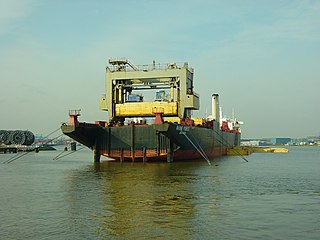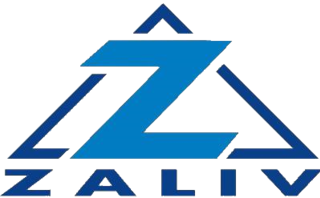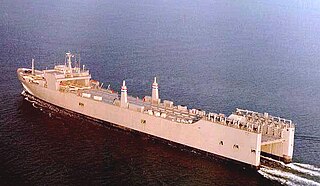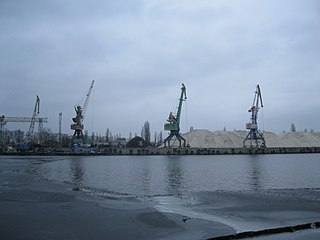
A dry dock is a narrow basin or vessel that can be flooded to allow a load to be floated in, then drained to allow that load to come to rest on a dry platform. Dry docks are used for the construction, maintenance, and repair of ships, boats, and other watercraft.
Concrete ships are built primarily with ferrocement hulls, reinforced with steel bars. This contrasts against more traditional materials, such as pure steel or wood. The advantage of ferrocement construction is that materials are cheap and readily available, while the disadvantages are that construction labor costs are high, as are operating costs. During the late 19th century, there were concrete river barges in Europe, and during both World War I and World War II, steel shortages led the US military to order the construction of small fleets of ocean-going concrete ships, the largest of which was the SS Selma. United States Maritime Administration (MARAD) designation for concrete ships-barges was Type B ship. Few concrete ships were completed in time to see wartime service during World War I, but during 1944 and 1945, concrete ships and barges were used to support U.S. and British invasions in Europe and the Pacific. Since the late 1930s, there have also been ferrocement pleasure boats.

The lighter aboard ship (LASH) system refers to the practice of loading barges (lighters) aboard a bigger vessel for transport. It was developed in response to a need to transport lighters, a type of unpowered barge, between inland waterways separated by open seas. Lighters are typically towed or pushed around harbors, canals or rivers and cannot be relocated under their own power. The carrier ships are known variously as LASH carriers, barge carriers, kangaroo ships or lighter transport ships.

Kuznia na Rybalskomu is a ship building and armament company in Kyiv, Ukraine. Situated on the Dnieper River and presently concentrating on river ships, the company is also able to produce and repair small sea vessels, as well as various military equipment.

The Black Sea Shipyard is a shipbuilding facility in Mykolaiv, Ukraine, on the southern tip of the Mykolaiv peninsula. It was founded in 1895 by Belgian interests and began building warships in 1901. At the beginning of World War I in 1914, it was one of the largest industrial facilities in the Russian Empire. The shipyard was moribund in the first decades of the Soviet Union until the Soviets began building up their fleet in the 1930s and it began building surface warships as well as submarines. The yard was badly damaged during World War II and took several years to be rebuilt. Surface warship construction temporarily ended in the mid-1950s before being revived in the mid-1960s and submarines were last built in the yard in late 1950s. The Black Sea Shipyard built all of the aircraft carrying ships of the USSR and Russia and continued before the 2022 Russian invasion of Ukraine to build large commercial ships.

Pioneering Spirit is a catamaran crane vessel owned by the Switzerland-based Allseas Group designed for the single-lift installation and removal of large oil and gas platforms and the installation of record-weight pipelines. The 382-metre-long (1,253 ft), 124-metre-wide (407 ft) vessel is the world's largest vessel by gross tonnage, and since September 2021 also the largest floating sheerleg in the world. It was built in South Korea by Daewoo Shipbuilding & Marine Engineering in 2013 at a cost of €2.6 billion. It commenced offshore operations in August 2016.

The Zaliv Shipbuilding Yard is located in Kerch, Crimea and specializes in the construction of tankers and container carriers, and the repair of ships of different types and tonnage.
The Kherson Shipyard is a joint stock company located in Kherson, Ukraine at the mouth of the Dnieper River. The shipyard specializes in building merchant ships to include dry cargo ships, tankers, ice-breakers, container-ships, drilling vessels, and floating dry docks. In 1983, the shipyard delivered the impressive Alexei Kosygin class of Arctic barge carriers.
Azov Shipyard, formerly known as Zhdanov Shipyard, located in Mariupol, Ukraine, is the largest ship repair enterprise in the Sea of Azov, specializing in ship repair, shipbuilding, mechanical engineering, and cargo transshipment. The company is managed by Mariupol Investment Group. It is a subsidiary of SCM Holdings.

Bay Shipbuilding Company (BSC) is a shipyard and dry dock company in Sturgeon Bay, Door County, Wisconsin. As of 2015, Bay Ships was a subsidiary of Fincantieri Marine Group and produces articulated tug and barges, OPA-90 compliant double hull tank ships and offshore support vessels. It also provides repair services to the lake freighter fleet. In the past the shipyard located in Sturgeon Bay has operated under several different names and traces its history back to 1918.
Odessos Shiprepair Yard is situated at the southern end of the city of Varna, Bulgaria, on the island between the old and new canals connecting the Black Sea and the Lake of Varna and is about one mile far from the mouth of Port Varna. Spread over an area of about 320,000 square meters, Odessos is the largest well-equipped yard in Bulgaria suitable for repair and drydocking of vessels up to 35,000 DWT and afloat repairs of vessels up to 150,000 DWT. Odessos Shiprepair Yard is the most busiest yard in the Black Sea.
The Ukrainian shipbuilding industry began to develop in times of the Cossacks.

Nibulon Shipbuilding-Shiprepair Plant is a Ukrainian shipyard that is located in Mykolaiv owned by agricultural company Nibulon. It is located right next to the Black Sea Shipyard.
Ukrainian Danube Shipping Company is a Ukrainian shipping company that specializes in water transportation along the Danube and Black Sea.

The Type B ship is a United States Maritime Administration (MARAD) designation for World War II barges. Barges are very low cost to build, operate and move. Barges were needed to move large bulky cargo. A tug boat, some classed as Type V ships, could move a barge, then depart and move on to the next task. That meant the barge did not have to be rushed to be unloaded or loaded. Toward the end of World War 2, some ships that had not been completed in time for the war were converted to barges. US Navy barges are given the prefix: YWN or YW. Due to shortage of steel during World War II, concrete ship constructors were given contracts to build concrete barges, with ferrocement and given the prefix YO, YOG, YOGN. Built in 1944 and 1945, some were named after elements.
Pollock-Stockton Shipbuilding Company was established in 1942 to build ships needed for World War II. As part of the Emergency Shipbuilding Program the US Navy provided some of the capital to start Pollock-Stockton Shipbuilding at Stockton, California. The shipyard was located at San Joaquin River and Stockton Channel, near Louis Park. After the war the shipyard closed down in February 1946.

Type C8-class ships are a type of Heavy Lift Barge Carrier. Type C8 ships were the 8th type of ship designed by the United States Maritime Commission (MARCOM) in the late 1960s. As done with the Type C1 ships and Type C2 ships, MARCOM circulated preliminary plans for comment. The design presented was not specific to any service or trade route. Type C8 ships measuring 876 feet (267 m) from stem to stern, and designed to make 16.2 knots.

Kremenchuk River Port also called Kremenchug River Port is a port located on the Dnipro in the city of Kremenchuk, Poltava Oblast, Ukraine. The Port of Kremenchuk has seven piers, as well as river stations in Kremenchuk, Svitlovodsk, and Horishni Plavni.











